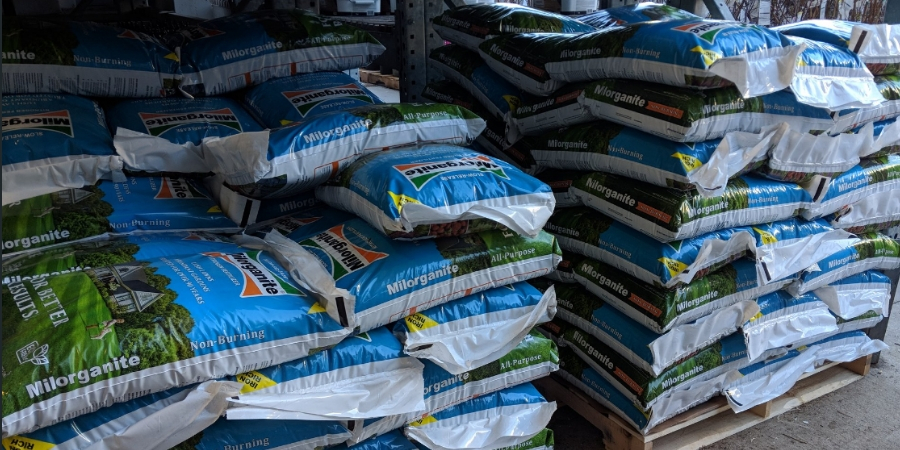There’s a Shortage of Milorganite
May 2, 2019If you’re looking for Milorganite at your local store, please don’t be surprised if they’re already running out. Stores across the country will have fewer bags of Milorganite this year—some significantly fewer or none at all.
Increased consumer demand for Milorganite is going to outpace the amount of Milorganite that can be produced and available on store shelves this year. We’re still producing a lot of Milorganite—an estimated 49,000 tons. That’s roughly 2.4 million bags! Even with that much Milorganite, there’s still more consumer demand than can be produced.

Supply and Demand Doesn’t Apply to Milorganite
Supply and demand is a basic economic principle. Simply put, as long as there’s a demand for a product, manufacturers will produce more of that product to meet the demand. Unfortunately, the same principle doesn’t hold true for Milorganite. It can’t be produced on the supply-and-demand model.
The amount of Milorganite we’re able to produce is completely dependent on the volume of wastewater coming into the system for treatment, limiting how much can be produced. Once that limit of “raw materials” is reached, there’s no way to produce more. It makes sense when you consider Milorganite is actually a byproduct of the region’s wastewater treatment process and not produced like a synthetic fertilizer.
It’s Cost Effective to Produce Milorganite
Milorganite uses what can be loosely termed a “cost-effective model.” The Milwaukee Metropolitan Sewerage District (MMSD), that creates Milorganite isn’t profit driven. It never has been and it never will be. Milorganite happens to be a byproduct of MMSD’s environmental goals to:
- maintain the health of our waterways, environment, and citizens by returning clean water to Lake Michigan;
- divert material from landfills; and,
- find the most cost-effective methods to do both.
Producing and distributing Milorganite happens to be the most cost-effective model for MMSD to achieve these goals.
Since 1926, for example, more than 9.9 billion lbs. of waste has been diverted from landfills. Why throw away such a great product?
How Milorganite is Produced
Milorganite is recycled nutrients and qualifies as one of the nation’s oldest recycling efforts. It’s a bag of nutrient-rich, dried microbes!
After microbes digest and run out of food—the nutrients found in wastewater—what remains is kiln dried into pellets. The product is analyzed daily to ensure guidelines are met for human health and the environment. Then it’s bagged and distributed throughout the nation.
Unlike synthetic fertilizers, we don’t mine or produce additional raw materials. The nutrients we use are those found in the region’s wastewater. We can’t increase the volume of wastewater. We don’t supplement Milorganite with additional nutrients, with the exception of iron, which is used as part of the water treatment process to effectively recover phosphorus and has the added benefit of enhancing the product’s iron content.
Looking for Ways to Increase Production
We continue to look for ways to increase production without impacting Milorganite’s quality. Through process improvements this year, we estimate a 5% increase in production.
We continue to explore opportunities to partner with other municipal water reclamation facilities, but only if it can produce a similar, high-quality product. To date, we have not found a partner.
Our promise to you is to continue to explore ways to increase supply while maintaining the long-standing, trusted attributes you’ve grown to expect.
Distribution and Unfortunate Price Increases
We don’t sell Milorganite directly to consumers. Milorganite is sold through distributors that then sell to retailers, who set the product price based on supply and demand. Many of our channel partners are linking their increases to transportation and distribution costs, as well as the marketplace working towards balancing supply and demand to ensure better in-stock rates.
As the manufacturer, we have maintained a steady wholesale cost of Milorganite with less than 2% annual increases over the last several years to our distributors. Increased distributor and retail pricing are beyond our control. We continue to share our customers’ concerns with our distribution partners regarding price increases. We urge you to share your concerns directly with your local retailers regarding this year’s price increases.
Finding Milorganite
If you’re a homeowner looking for Milorganite, visit our store locator page to find retailers in your area that may have it in stock. Save time and either call ahead or check your local retailers’ websites’ for availability to ensure they have Milorganite in stock before making the trip to the store.
If we could produce more Milorganite, we certainly would. Our advice? If you find Milorganite, buy it!
Here’s to Better Results,
JeffJeff Spence
Director of Sales & Marketing, Milorganite

